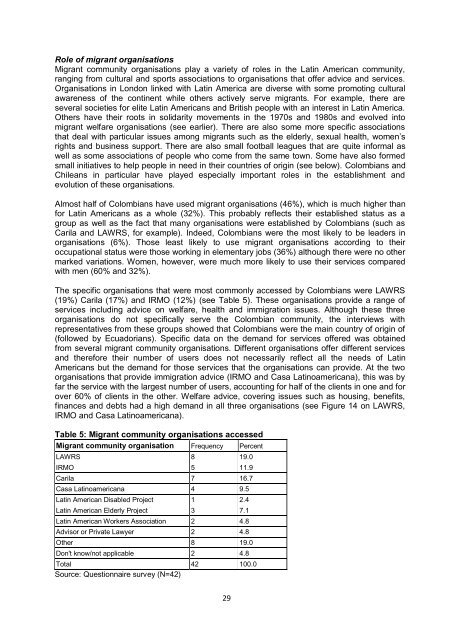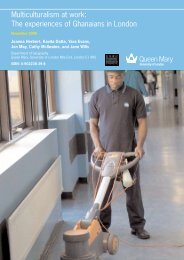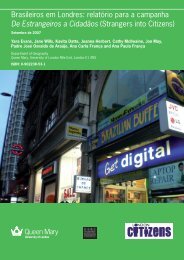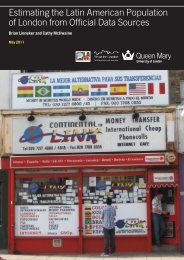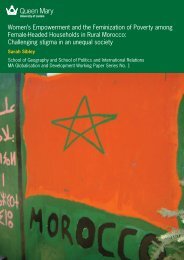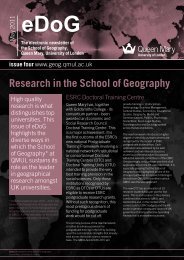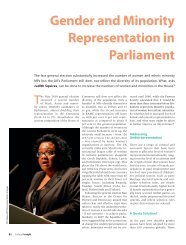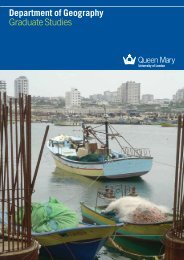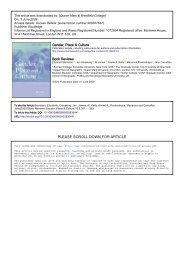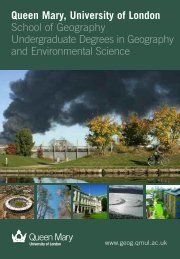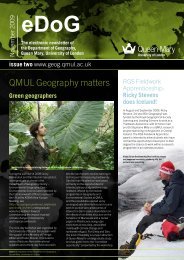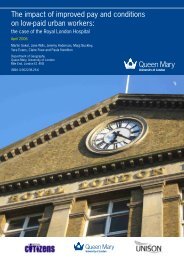The Colombian community in London - Geography - Queen Mary ...
The Colombian community in London - Geography - Queen Mary ...
The Colombian community in London - Geography - Queen Mary ...
- No tags were found...
Create successful ePaper yourself
Turn your PDF publications into a flip-book with our unique Google optimized e-Paper software.
Role of migrant organisations<br />
Migrant <strong>community</strong> organisations play a variety of roles <strong>in</strong> the Lat<strong>in</strong> American <strong>community</strong>,<br />
rang<strong>in</strong>g from cultural and sports associations to organisations that offer advice and services.<br />
Organisations <strong>in</strong> <strong>London</strong> l<strong>in</strong>ked with Lat<strong>in</strong> America are diverse with some promot<strong>in</strong>g cultural<br />
awareness of the cont<strong>in</strong>ent while others actively serve migrants. For example, there are<br />
several societies for elite Lat<strong>in</strong> Americans and British people with an <strong>in</strong>terest <strong>in</strong> Lat<strong>in</strong> America.<br />
Others have their roots <strong>in</strong> solidarity movements <strong>in</strong> the 1970s and 1980s and evolved <strong>in</strong>to<br />
migrant welfare organisations (see earlier). <strong>The</strong>re are also some more specific associations<br />
that deal with particular issues among migrants such as the elderly, sexual health, women‟s<br />
rights and bus<strong>in</strong>ess support. <strong>The</strong>re are also small football leagues that are quite <strong>in</strong>formal as<br />
well as some associations of people who come from the same town. Some have also formed<br />
small <strong>in</strong>itiatives to help people <strong>in</strong> need <strong>in</strong> their countries of orig<strong>in</strong> (see below). <strong>Colombian</strong>s and<br />
Chileans <strong>in</strong> particular have played especially important roles <strong>in</strong> the establishment and<br />
evolution of these organisations.<br />
Almost half of <strong>Colombian</strong>s have used migrant organisations (46%), which is much higher than<br />
for Lat<strong>in</strong> Americans as a whole (32%). This probably reflects their established status as a<br />
group as well as the fact that many organisations were established by <strong>Colombian</strong>s (such as<br />
Carila and LAWRS, for example). Indeed, <strong>Colombian</strong>s were the most likely to be leaders <strong>in</strong><br />
organisations (6%). Those least likely to use migrant organisations accord<strong>in</strong>g to their<br />
occupational status were those work<strong>in</strong>g <strong>in</strong> elementary jobs (36%) although there were no other<br />
marked variations. Women, however, were much more likely to use their services compared<br />
with men (60% and 32%).<br />
<strong>The</strong> specific organisations that were most commonly accessed by <strong>Colombian</strong>s were LAWRS<br />
(19%) Carila (17%) and IRMO (12%) (see Table 5). <strong>The</strong>se organisations provide a range of<br />
services <strong>in</strong>clud<strong>in</strong>g advice on welfare, health and immigration issues. Although these three<br />
organisations do not specifically serve the <strong>Colombian</strong> <strong>community</strong>, the <strong>in</strong>terviews with<br />
representatives from these groups showed that <strong>Colombian</strong>s were the ma<strong>in</strong> country of orig<strong>in</strong> of<br />
(followed by Ecuadorians). Specific data on the demand for services offered was obta<strong>in</strong>ed<br />
from several migrant <strong>community</strong> organisations. Different organisations offer different services<br />
and therefore their number of users does not necessarily reflect all the needs of Lat<strong>in</strong><br />
Americans but the demand for those services that the organisations can provide. At the two<br />
organisations that provide immigration advice (IRMO and Casa Lat<strong>in</strong>oamericana), this was by<br />
far the service with the largest number of users, account<strong>in</strong>g for half of the clients <strong>in</strong> one and for<br />
over 60% of clients <strong>in</strong> the other. Welfare advice, cover<strong>in</strong>g issues such as hous<strong>in</strong>g, benefits,<br />
f<strong>in</strong>ances and debts had a high demand <strong>in</strong> all three organisations (see Figure 14 on LAWRS,<br />
IRMO and Casa Lat<strong>in</strong>oamericana).<br />
Table 5: Migrant <strong>community</strong> organisations accessed<br />
Migrant <strong>community</strong> organisation Frequency Percent<br />
LAWRS 8 19.0<br />
IRMO 5 11.9<br />
Carila 7 16.7<br />
Casa Lat<strong>in</strong>oamericana 4 9.5<br />
Lat<strong>in</strong> American Disabled Project 1 2.4<br />
Lat<strong>in</strong> American Elderly Project 3 7.1<br />
Lat<strong>in</strong> American Workers Association 2 4.8<br />
Advisor or Private Lawyer 2 4.8<br />
Other 8 19.0<br />
Don't know/not applicable 2 4.8<br />
Total 42 100.0<br />
Source: Questionnaire survey (N=42)<br />
29


